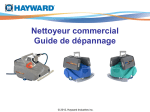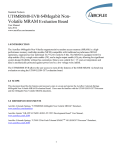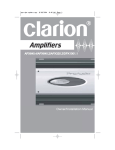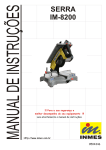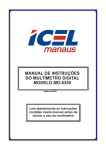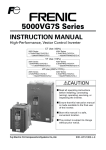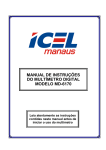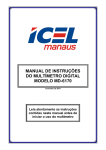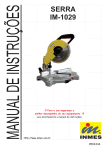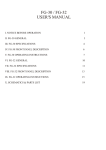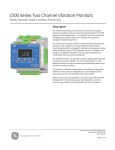Download Commercial Cleaner Troubleshooting Guide
Transcript
Commercial Cleaner Troubleshooting Guide © 2012 Hayward Industries Inc. TABLE OF CONTENTS KingShark 2 and KingShark 2 Plus Safety Precautions Page 1 Motor Removal Page 18 Service Tools Page 2 Pump Housing / Gear Box Disassembly Page 19 Special Notes Pages 3-4 Solenoid Disassembly Page 20 Removal of Hood Pages 5-6 Bumper / Cable Assembly Removal Page 21 Filter Removal Pages 7-8 Cable Assembly Components Page 22 Power Cord Removal Page 9 Control Panel Components Pages 23-25 Swivel Removal Page 10 Control Panel Troubleshooting Pages 26-28 Accessing the Impeller Page 11 Control Panel Timer / Relay PCB Testing Pages 29-31 Drive Belt Removal Page 12 Swivel Voltage Testing Page 32 Intake Removal Page 13 Motor / Power Cord Voltage Testing Pages 33-35 Drive Wheel Pages 14-17 KingShark 2 / KingShark 2 Plus Tips Serial number locator Mako Shark 2 and KingShark Troubleshooting begins on Page 39 Page 36 Page 37-38 Safety Disconnecting and removing the unit from the pool immediately after each use will enhance the cleaner’s life. 150 minutes of operation in a 30’ x 60’ pool should be sufficient with no more than a few twists in the cord which should be straightened out after each use. Page 1 Service Tools 3/8“, 5/16“, 7/16“, 1/2" Wrench Snap Ring Pliers 5/32“, 1/4“ Allen Wrench Flat Tip and Phillips Screwdriver Needle Nose Pliers 3/8“ Ratchet Small Flat Tip Screwdriver 3/8“, 7/16“, 1/2“ Socket 3/8“ Socket Extension 1/4“ Socket Driver Page 2 Special Notes When disassembling the KingShark 2 and the KingShark 2 Plus, the ONLY DIFFERENCES between the two cleaners are as follows: KingShark 2 1. Standard 3 prong electrical cord 2. RCX400388 3/4 h.p. w/o swivel. 3. RCX4011 3/4 h.p. w/ swivel. KingShark 2 Plus 1. Different pigtail connections. 2. KingShark 2 Plus has a remote. 3. KingShark 2 Plus has a cannon plug for the control panel. 4. KingShark 2 Plus has solenoids which control left and right movement from the remote. 5. RCX4020 3/4 h.p. The remote has a maximum communication line to the antenna of 150’. Page 3 230 VAC Supply to Master Control Panel When supplying 230 VAC instead of 115 VAC to the Master control panel, the following jumper cable switch must be moved. 1. Move the jumper wire connection E9 to E7 230 VAC connection on the RELAY BOARD just above the transformer. 2. Hard wire the power cord to a dedicated 10-15 amp breaker. The master control panel draws roughly 3 amps. E9 ONLY move the E9 connection Jumper configured for 240 VAC Page 4 Removal of Hood Step 1: Step 2: Remove the two 1/4" – 20 X 3/4" SS bolts from both sides of the cleaner using a 7/16” socket. Pull the cartridge handle quick release UP and then pull the cartridge assembly back and away from the cleaner. Note: 1 bolt and 2 plastic washers per side Page 5 Removal of Hood Step 3: Unscrew the filter retainer knob using a 5/32” Allen Wrench. Step 4: Slide the hood cover over the swivel assembly. Page 6 Filter Removal Step 5: Pull up on the yellow quick release handle assembly. Step 6: Pull and slide the filter assembly backwards and away from the cleaner. Page 7 Filter Removal Step 7: Remove the push style clips Lift the housing assembly off the tie rods Lift the cartridges up and off the / back plate. back plate. To clean the filters, spray with clean water. Back Plate Note : Never remove or adjust the 4 nuts Page 8 Power Cord Removal Step 8: 1. Using a flat tip screwdriver and 3/8” wrench, remove the swivel cord clamp. 2. Using a Phillips screwdriver, remove the four screws connecting the power end to the swivel. 3. When reconnecting the power end to the swivel or motor, make sure to use RTV # 162 silicone rubber sealant and replace the o-ring. 1. 2. 3. o-ring Page 9 Swivel Removal Step 9: Using a 7/16” socket, remove the two 1/4" – 20 X 1-1/4" hex head bolts from the swivel mounting bracket. Remove the four screws connecting the power cord to the motor end. Note: Make sure to use RTV # 162 Silicone Rubber Sealant when reconnecting the power cord and replace the o-ring. Page 10 Accessing the Impeller Step 10: 1. Use a 7/16" socket to remove the two plastic bolts and impeller access plate from the pump housing. 2. After removing the impeller access plate, this will allow you to inspect the impeller and check for debris or damage inside the impeller area. 1. 2. Page 11 Drive Belt Removal Step 11: 1. Remove right side drive belt. 2. Remove left side drive belt. Note : When putting the drive belts back on, put the LEFT side on first, then the RIGHT side. This will prevent possible torque damage where the gear box assembly meets the front housing bell, since the larger support bracket is on the left side of the gearbox assembly. Page 12 Intake Removal Step 12: 1. Unscrew the 4 screws holding the intake to the base plate, also remove the SS wire baffle. 2. Remove the intake stabilizer from the intake. The stabilizer prevents large debris from entering the cleaner. 1. 2. NOTE : When removing and reinstalling the Intake, be aware of the 2 plastic washers that seat between the Intake and the base plate. Page 13 Drive Wheel Disassembly Step 13: 1. Using the snap ring pliers, remove the snap ring from the front wheels and the rear drive wheels. 2. After removing the snap rings from the wheels, pull the front wheels from the base plate and remove the drive wheels from the gear box assembly. 1. Front Wheels 2. Drive Wheels Note : There is one SS washer on each side of the gear arm. Note: There is one 1/8" SS Key on each rear drive wheel It is important the key is installed into the wheel prior to inserting the shaft. Page 14 Drive Wheel Disassembly Step 14: 1. Use the snap ring pliers to remove the 4 E-Clips from the L & R drive wheels. Remove the 4 plastic washers / spacers. 2. Remove the 2 indicator screws from the drive wheels – Each set of screws indicate LEFT drive wheel specific or RIGHT drive wheel specific. Below the 2 indicator screws, the letter L or R will be molded into the wheel. 1. 2. Page 15 Drive Wheel Disassembly Step 15: 1. Remove the 4 Button Washers 2. Remove the Gear Ring 4. Remove the 4 Planetary Gears 3. Remove the Sun Gear 5. Remove the Wheel Lock Page 16 Drive Wheel Reassembly 1. When reinstalling the drive wheels, make sure the Wheel Locks are installed in the correct direction and position. The photo’s below indicate the correct position and direction. 2. The outside wheel plate screws must match the L or R indicator markings on the outside wheel plates. 1. 2. L R LEFT DRIVE WHEEL RIGHT DRIVE WHEEL Page 17 Motor Separation Step 16: 1. Use a 1/4" allen wrench to remove the 2 bolts and washers. Once these are removed, lift the motor from the base plate. 2. Use a 1/2" socket to remove the 5 bolts and washers that hold the motor to the pump housing. 3. Use a flat tip screw driver to remove the 4 impeller screws. 4. Unscrew the 2 screws and 1 - 7/16” bolt to separate the motor from the housing bell. 1. 2. 3. 4. Left View Right View Page 18 Pump Housing / Gear Box Disassembly Step 17: 1. Use a 7/16" socket to remove the 3 bolts from the pump housing. Pull the pump housing from the gear box assembly. 2. After removing the 3 - 7/16" bolts, note the length and location of each bolt for reinstallation. 1. 2. Gear Box Assembly Pump Housing Page 19 Solenoid Disassembly Step 18: 1. Use a 7/16" wrench to remove the 4 retention nuts from the U bolts. 2. Once the 4 retention nuts are removed, the solenoids can be set aside. To separate the solenoids from the motor, pull and separate at the quick connection at the solenoid. Note: Solenoids are marked left (L) and right (R) . The power cord that has the black lines indicates the right solenoid connection. (see insert picture, photo #2) 1. 2. Page 20 Bumper / Cable Assembly Removal Step 19: 1. Remove the two 3/8” nuts (top), four flathead screws (center), and two pins (bottom). 2. Slide the bumper from the arm sensor bar. 1. Note: Both the reversing arms and cable assembly can be turned over and be reused 2. Page 21 Instructions for Reinstalling the Cable Assembly Back to front view - TOP Cable assembly’s do not come pre-tensioned from the manufacturer 1. Tension cables / cable assembly are adjustable. 2. Once the cable assembly is reinstalled, push in on the sensor bar. The L & R reversing arms should touch the inside of the drive wheels. 3. Release the sensor bar, it should “spring“ back to it’s normal position, if it doesn’t, tighten or loosen accordingly (blue). 2 plastic spacers 1 plastic spacer (BOTTOM) (TOP) Cable Assembly Note the proper location of the washers and spacer when reinstalling the L & R reversing arms. underneath view L side top view R side top view Page 22 Master Control Panel Relay Board / Receiver Board 24 VDC relays Transformer Antenna Receiver Board AC to DC rectifier Relay Board 24 VDC relays Power out to cleaner Incoming power supply Page 23 Master Control Panel Timer Board (Back Side of Front Panel) Display ribbon cable Note: Ribbon cable disconnects at the Timer Board Power On / Off Switch Fuse Power Indicator Light Auto Turn On / Off Switch Page 24 Master Control Panel Step 20: 1. Power cord MUST be plugged into a grounded electrical outlet equipped with a Ground Fault Circuit Interrupter ( GFCI ) If you supply power to the master control panel and you have no display, this is NORMAL. Unless you have the Cannon Plug power cord from the swivel connected to the 2 center ports, the display will be blank. This will prevent any shocking hazards that may occur with the power connection at the master control panel. 1. Page 25 Master Control Panel Step 21: Correct power to Master Control Panel but NO display 1. Make sure power is ON. Put one meter lead on L1 connection and one lead on L2, 115 VAC should be present. 2. Put meter lead on the on/off switch and one lead to ground, 115 VAC should be present. 1. 2. NOTE: Check voltage on LEFT connection of switch Page 26 Master Control Panel Correct power to Master Control Panel and NO display Check for a blown fuse. Twist the fuse left and pull out for access. Slo-Blo 1 amp / 250VP Do a continuity check on the fuse to verify if fuse is good or bad Page 27 Master Control Panel Cannon Plug Step 22: To verify 115 VAC is being supplied through the female cannon plug receiver, install a jumper wire into the 2 center ports. Power the unit on and press the“Start“ button until “RUN“ is on the display. Then, stick one meter lead into the black port and the other lead into the white or green port. 115 VAC + or - should be present. 115 VAC BRN YEL R BLACK 24 VDC BL R GR WH Page 28 Master Control Panel Step 23: Timer PCB Testing On RELAY PCB at REMOTE J4 - Using RED lead of DC voltmeter at green wire on J4 and BLACK lead of DC voltmeter at COM (E12). Voltmeter should read 24 VDC. Now, push RIGHT TURN button on the remote, voltmeter should read 0 VDC - Do the same test procedure on the RED wire – push LEFT TURN button on the remote, voltmeter should read 0 VDC If the unit still does not run, proceed to Step 25 on Page 32. Page 29 Master Control Panel Step 24: RELAY PCB Testing On RELAY PCB at J3 (B A G H F) Yellow wire is the common wire to both solenoids Blue wire is the LEFT Turn solenoid Brown wire is the RIGHT Turn solenoid - Using DC Voltmeter, check voltage between the yellow wire and the blue wire. 24 VDC should be present while pushing the LEFT TURN button on the remote - Using DC Voltmeter, check voltage between the yellow wire and the brown wire. 24 VDC should be present while pushing the RIGHT TURN button on the remote. - Using DC Voltmeter, check voltage between either the brown or blue wire to yellow. 24 VDC should be present while pushing the REVERSE TURN button on the remote. Note: Voltage can vary between 22-28 VDC or Page 30 Master Control Panel Step 25: 1. After testing the RELAY PCB Board (Step 24), if the tests do not match the correct voltages, then the RELAY PCB Board will need to be replaced. 2. If the problem still exists after replacing the RELAY PCB Board, remove the cannon plug from the master control panel. Insert the jumper wire into the 2 center ports of the connector plug at the master control panel. Repeat steps 24 & 25. If steps 24 & 25 pass the testing, the motor and cord need to be test separately to determine which one needs to be replaced. 1. 2. Page 31 Voltage Check to Swivel Step 26: To verify voltage is passing through the power supply cord to the swivel : 1. Power the system off 2. Disconnect the power end connection at the swivel 3.Power the system ON and make sure the RUN light is illuminated. . 4. Put meter leads on the black and white ports. 115 VAC should be present. If not, verify breaker is good, ON switch is ON, and all power is correct. POWER END CONNECTION WH BLACK power cord Page 32 Voltage Check to Motor Step 27: To verify voltage is getting through the swivel to the MOTOR : 1. 2. 3. 4. Power the system off Disconnect the power end connection at the motor Power the system on and make sure the RUN light is on the display Put meter leads on the white and black ports, you should get 115 VAC Old motor New motor Power end connection WH BLACK cord Page 33 Ohm Check at Motor Step 28: Ohm meter -0.9 ohms-1.3 ohms for 115 VAC -4.3 ohms-6.3 ohms for 240 VAC Page 34 Cord Inspection Step 29: Undo the power connection at the swivel. Remember to replace the o-ring and to use RTV #162 silicone rubber sealant when reconnecting the swivel connector end. 1. Make sure the cannon plug is connected. Power the unit on. Press the start button until Run is displayed. 2. Put one meter lead into the white port, and one meter lead into the black port at the swivel connector end where it connects to the swivel. 115 VAC should be present. 1. 2. WH BR BLACK cord direction BLUE GR YELLOW SWIVEL CONNECTOR END Page 35 KingShark 2 / KingShark 2 Plus Tips Sensor Bar adjustments and other minor repairs (Make all adjustments in ¼" increments) A. Raise Sensor Bar if machine: 1. Fails to climb out of deep end. 2. Turns or hesitates on pool drain. 3. Turns away from curved wall too soon. B. Lower Sensor Bar if: 1. Tips over before tripping or sensing wall. 2. Turns or hesitates on pool drain. C. Sensor Bar adjustments required if machine turns in circles or twists cord: 1. Sensor bar not level or too high, possibly hitting the hood. 2. Thread on reversing arm is worn or stripped, not allowing reversing mechanism to disengage. 3. Sensor Bar Cable screws are loose. 4. Sensor Bar Cable is broken. 5. Drive Wheel is broken. Check Sensor Bar regularly and keep the sensor bar level at all times ! Loss of vacuuming action 1. Filter may be clogged, slowing the flow of water through the unit. Clean the filters. 2. Suction area may be obstructed by large debris. Unplug power cord and remove obstruction. No apparent power 1. Electrical outlet may be dead. Check electrical GFCI outlet. Check Fuses and breakers. Verify power switch is on. 2. Object lodged in the impeller. 3. Unit runs for a short distance and stops. Check for over load of the electrical circuit or faulty motor. DO NOT USE EXTENSION CORDS 4. Motor runs but machine becomes or is motionless. Gear box could be worn or drive pin could be sheared. Machine tips over 1. Filters are dirty. 2. Sensor Bar set too high. 3. Tipping in certain situation can be prevented by purchasing a float and installing per instructions. Disconnecting and removing the unit from the pool immediately after each use will enhance the life of the cleaner. 4 hours operation in a 50’ x 100’ pool should be sufficient with not more than a few twists in the cord which should be straightened out after each use. Page 36 Serial Number Locations – March 2010 & prior Serial numbers for the Commercial Units can be found in the three locations indicated below First two numbers of a serial number: 10 = MAKOSHARK 30 = MAKOSHARK2 50 = KINGSHARK 70 = KINGSHARK2 90 = KINGSHARK2 PLUS LETTER: A=January B=February C=March D=April E=May F=June G=July H=August J=September K=October L=November M=December * Fourth Position indicates year of manufacture For example, 9 = 2009 (bottom side of Gear Box Assembly) Page 37 Serial Number Locations after March 2010 Currently we are using the 17 digit serial number sequence used on Hayward products. This will be located on the gear box assembly and on the motor. Example: Model # RC9860DCC Serial # 21121102005246000 2112 - location made 11 - year made 02 - month made Page 38 Mako 2 & King Shark Troubleshooting TABLE OF CONTENTS Filter Removal Page 40 Handle Removal Page 41 Filter Housing Removal Page 42 Hood Removal Page 43 Cord Assembly Removal Page 44 Drive Belt Removal Page 45 Gearbox Assembly Removal Page 46 Impeller and Motor Removal Pages 47-48 Pump Housing and Base Disassembly Pages 49-52 Troubleshooting Pages 53-54 Page 39 Filter Removal Step 1: Remove both clips from the rear of the unit. Step 3: Remove filter elements. Step 2: Remove the back cover from . the filter housing. Note: Elements can be cleaned by gently spraying with a garden hose. Be careful not to use high pressure as this may cause damage to the elements. Page 40 Handle Removal Step 1: Use a flat head screwdriver on both ends of the handle pin to unscrew and remove. Page 41 Filter Housing Removal Step 1: Slide Ring Adapter off the housing and remove the two screws to remove the ring adapter from cord. Step 2: Lift the filter housing from the cleaner. Page 42 Hood Removal Step 1: Remove the bolt from the handle riser using 7/16” socket. Step 3: Remove the hat riser. Step 2: Remove the handle riser. Step 4: Lift the body off. Page 43 Cord Assembly Removal Step 1: Remove the bolt from the pump housing using a 7/16" socket. Step 2: Remove the 4 screws from the motor. Step 3: Pull the plug away from the motor. Note: When replacing the cord assembly clean surface thoroughly and use new o-ring and RTV #162 White Silicone for a water tight seal. Page 44 Drive Belt Removal Step 1: Looking at the cleaner from the rear, remove the RIGHT drive belt from the rear wheel, and then the front wheel. Step 2: Remove the LEFT belt. 1. 2. 3. 4. Note: Look at the cleaner from the rear and note that the gear box has a Support on the left side of the unit. Left Right Note: When installing the drive belts install the left belt first and then the right belt. This will remove stress from the right side of the gearbox which does not have the additional support. Page 45 Gear Box Assembly Removal Step 1: Remove the five bolts from the rear of the gear box assembly using a 7/16" socket. Step 2: Pull the gear box away from the pump housing. 1 2 3 Gear Box 4 5 Page 46 Impeller and Motor Removal Step 1: Pull the impeller from the impeller drive collar. Step 2: Pull the impeller drive collar from the motor shaft. Page 47 Impeller and Motor Removal Step 3: Remove the 3 motor screws. Step 4: Slide the motor away from the pump housing. 1. 2. 3. Page 48 Pump Housing and Base Disassembly Step 1: Remove the 2 blue intake blades by pulling them from the slide. Step 2: Remove the two bolts from the bottom of the unit using a 1/2" socket. Step 3: Remove the pump housing from the base. Page 49 Pump Housing and Base Disassembly Step 4: Remove the snap ring from the front wheel. Step 5: Slide the wheel off of the axle. Step 6: Repeat the 2 previous steps on the opposite side of the base. Note: Sensor Bar and Reversing Arms are both reversible. As they become worn, they can be turned over to use the other side. This will extend the life of the part. Page 50 Pump Housing and Base Disassembly Step 7: Remove the 2 flat head screws from the sensor bar. This will allow removal of the sensor bar from the base. Step 8: Pull the 2 cotter pins at the opposite end of the cables. Page 51 Pump Housing and Base Disassembly Step 9: Remove the two bolts from the reversing arms using a 5/16” socket. Note: There are washers located on either side of the reversing arm to allow smooth movement. Washer locations Note: The steps to disassemble & reassemble the drive wheels are identical to those of the KingShark II and KingShark II Plus. Detailed steps can be found on pages 14 – 17. Page 52 Troubleshooting Sensor Bar adjustments and other minor repairs (make all adjustments in ¼” increments). A. Raise Sensor Bar if machine: 1. Fails to climb out of the deep end. 2. Turns or hesitates on pool drain. 3. Turns away from curved wall too soon. B. Lower Sensor Bar if: 1. Tips over before tripping or sensing wall. 2. Turns or hesitates on pool drain. C. Sensor Bar adjustments required if machine turns in circles or twists cord. 1. Sensor Bar not level or too high possible hitting hood. OR 2. Thread on reversing arm #RC1703 is worn or stripped not allowing reversing mechanism to disengage. 3. Sensor Bar cable screws are loose. 4. Sensor Bar cable is broken. 5. Drive wheel is broken. D. Remember this basic rule: Check Sensor Bar regularly and keep the Sensor Bar level at ALL times. Page 53 Troubleshooting Loss of vacuuming action: A. Filter may be clogged, slowing the flow of water through the unit. Clean the filters. B. Suction area may be obstructed by large object. No apparent power: A. If the machine does not move: 1. Verify power at the electrical outlet. 2. Object lodged in impeller. 3. A short in the motor, check the ground fault interrupter. 4. Unit runs for a short distance and stops. Check for overload of the electrical circuit or faulty motor. (DO NOT use extension cords.) 5. Motor runs but machine becomes or is motionless. Gear box could be worn or drive pin could be sheared. Machine tips over: A. Filter loaded with sand or debris. B. Sensor Bar is set too high. Page 54
























































